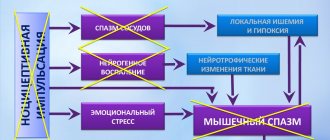Sirdalud
Sirdalud (active ingredient - tizanidine) is a central muscle relaxant that acts directly on the spinal cord. The main point of application of his efforts are presynaptic alpha-2 receptors. By stimulating them, sirdalud prevents the release of amino acids that excite receptors for N-methyl-D-aspartate. As a result, at the level of interneurons (interneurons) of the spinal cord, polysynaptic transmission of nerve impulses is inhibited. Since this mechanism is responsible for excessive muscle tone, when it is suppressed, a decrease in muscle tone will be observed. In addition to the muscle relaxant effect, sirdalud also has a moderately pronounced central analgesic effect. The drug is effective both for acute spastic muscle pain and for chronic muscle spasm of spinal and cerebral origin. Sirdalud reduces spasticity and stops clonic convulsions, as a result of which the physiological barrier to passive movements is removed and the range of active movements increases. Therapeutic effectiveness and severity of unwanted side reactions depend on the content of the active substance in the blood. The drug is quickly and completely absorbed in the gastrointestinal tract. The maximum concentration of the active component in the blood plasma is achieved on average 1 hour after taking the drug. The bioavailability of sirdalud is relatively low - about 35%, which is due to the effect of the first passage through the liver. The pharmacokinetic characteristics of the drug when taken with food change slightly. The half-life of sirdalud averages 2-4 hours. Excretion of the drug from the body is carried out mainly by the kidneys.
Sirdalud is available in tablets. The drug has a narrow therapeutic range, which requires careful selection of the dose in order to protect the patient as much as possible. It was experimentally found that a starting dose of 2 mg 3 times a day can minimize the risk of side effects. In any case, the dose should be selected individually.
For spastic muscle pain, 2 or 4 mg are usually prescribed three times a day, with the possibility of taking an additional dose in especially severe cases (optimally before bedtime). For spasticity of striated muscles associated with neurological diseases, the starting dose of the drug should be no more than 6 mg per day. The dose should be increased gradually, at intervals of 3-7 days. In most cases, a pronounced therapeutic effect can be achieved at a dose of 12-24 mg per day. The maximum daily dose is 36 mg. There is little experience with the use of sirdalud in people over 65 years of age. In such patients, pharmacotherapy begins with the minimum effective doses, followed by a gradual increase in order to achieve an acceptable ratio of effectiveness and tolerability of therapy. When stopping taking the drug, to reduce the likelihood of developing withdrawal syndrome, manifested in this case by increased blood pressure and tachycardia, it is necessary to slowly reduce the dose until the drug is completely stopped. This is especially true for individuals who have taken sirdalud for an extended period of time. Arterial hypotension that develops while taking sirdalud may be the result of its interaction with antihypertensive drugs or CYP1A2 inhibitors. A number of sources provided information about liver dysfunction caused by tizanidine, but this did not apply to those cases where the drug was used in daily doses of less than 12 mg. In any case, it is recommended to monitor liver function indicators once a month, at least at the initial stage of treatment (and subsequently - only if appropriate clinical signs are present). A 30% decrease in the systemic bioavailability of sirdalud was found in men who smoke more than 10 cigarettes per day. During treatment, it is recommended to abstain from another human vice - drinking alcohol, because... otherwise, the risk of side effects increases.
SIRDALUD (tablets)
It is in a state of rest and this is where painful sensations appear that cannot be expressed in words, I think that someone is familiar with them, when “the veins are being pulled out of you.”
There are 30 capsules in a box of 6 mg each (there is also a dosage of 4 mg)
All information is written in Russian and English. The active substance in this drug is tizanidine, it is thanks to it that increased muscle tone is reduced and spasm is relieved. Spinal reflexes are suppressed and a muscle-relaxing effect occurs, that is, convulsions stop.
Surdalud MR was released in Turkey under license from a Swiss company.
The box contains the date of manufacture and expiration date of the drug.
Now the price. I can’t say that it’s too high, considering that this is exactly one month of use. But the question arises: why not just prescribe tizanidine for 100 rubles?
The indications for this drug are quite narrow, namely spasms and convulsions for various reasons.
Contraindications: age under 18 years, severe liver dysfunction, incompatibility with certain medications, all this is described in detail in the instructions.
Side effects: here, like most medications, there is a ready-made, but not published, horror book. BUT, like any drug, if you take it strictly according to the doctor’s recommendations (and I still advise you to read the instructions, since many doctors are too zealous in treatment), then the risk of side effects will be minimal.
The box contains three blisters of 10 capsules.
Sirdalud is taken once a day, preferably in the first half of the day (food intake has no effect), because the maximum effect begins after 8-9 hours. Abrupt discontinuation of the drug is not recommended; it is advisable to gradually reduce the dose until complete discontinuation. But according to the doctor, they do not refuse sirdalud completely, because with a good outcome of treatment, you can switch to taking it once every 2-3 days and even up to once every 5 days.
Which is exactly what happened. Mom took Sirdalud every day for almost 20 days, as she said: I’m already afraid to jinx it and say that the drug helps and the leg cramps have stopped. Then she started taking sirdalud every other day, now after more than a month, 1 capsule every 2-3 days is enough for my mother.
Modified release capsules - do you know what they are? What progress has come! This shell - a capsule - made using a special technology allows you to program and control the rate of release of the drug that is inside it! And here is the answer to the question - why didn’t the doctor prescribe cheap tizanidine!
White opaque capsules with the name of the drug and dosage written on them.
Of course, only a doctor can prescribe medications after studying each specific case of the disease and symptoms. If you are prescribed Sirdalud MR during treatment, then I recommend paying attention to it. In this particular case, this drug worked well.
Health and good mood to everyone!
Sirdalud®
When using the drug Sirdalud® with inhibitors of the CYP1A2 isoenzyme, an increase in the concentration of tizanidine in the blood plasma is possible. In turn, an increase in the concentration of tizanidine in the blood plasma can lead to symptoms of drug overdose, including prolongation of the QT(c) interval.
The simultaneous use of Sirdalud® with inducers of the CYP1A2 isoenzyme may lead to a decrease in the concentration of tizanidine in the blood plasma, which may lead to a decrease in the therapeutic effect of the drug.
Contraindicated combinations with tizanidine
The simultaneous use of tizanidine with fluvoxamine or ciprofloxacin, inhibitors of the CYP1A2 isoenzyme, is contraindicated.
When tizanidine was used with fluvoxamine or ciprofloxacin, a 33-fold and 10-fold increase in tizanidine AUC was observed, respectively. The result of simultaneous use may be significant and prolonged hypotension accompanied by drowsiness, dizziness, and a decrease in the speed of psychomotor reactions (in some cases, up to circulatory collapse and loss of consciousness).
Not recommended combinations with tizanidine
It is not recommended to use tizanidine simultaneously with other inhibitors of the CYP1A2 isoenzyme - antiarrhythmic drugs (amiodarone, mexiletine, propafenone), cimetidine, some fluoroquinolones (enoxacin, pefloxacin, norfloxacin), rofecoxib, oral contraceptives, ticlopidine.
Combinations with tizanidine
requiring caution Caution
must be exercised when using Sirdalud® simultaneously with drugs that prolong the QT interval (for example, cisapride, amitriptyline, azithromycin) .
Antihypertensive drugs
The simultaneous use of Sirdalud® with antihypertensive drugs, including diuretics, can sometimes cause a pronounced decrease in blood pressure (in some cases, up to circulatory collapse and loss of consciousness) and bradycardia.
When the drug Sirdalud® was abruptly discontinued after simultaneous use with antihypertensive drugs, the development of tachycardia and an increase in blood pressure was observed, which in some cases can lead to acute cerebrovascular accident.
Rifampicin
Simultaneous administration of tizanidine and rifampicin leads to a 50% decrease in the concentration of tizanidine in the blood plasma. As a result, the therapeutic effect of the drug may be reduced, which may be clinically significant for some patients. Long-term simultaneous use of rifampicin and tizanidine should be avoided; if impossible, careful selection of the dose of tizanidine (increase) is recommended.
Smoking tobacco
The systemic bioavailability of tizanidine in smoking patients (more than 10 cigarettes per day) is reduced by approximately 30%. Long-term drug therapy in patients in this category may require higher doses of tizanidine than the average therapeutic dose.
Alcohol
During drug therapy, you should avoid drinking alcohol, as it may increase the likelihood of adverse events (for example, decreased blood pressure and lethargy). Tizanidine may enhance the depressant effect of alcohol on the central nervous system.
Other medicines
Sedatives, hypnotics (benzodiazepine, baclofen) and other drugs such as antihistamines may also increase the sedative effect of tizanidine. Avoid taking the drug with other alpha2-adrenergic agonists (eg, clonidine) due to the potential for increased hypotensive effects.
Sirdalud® MR (Sirdalud® MR)
With simultaneous use of the drug Sirdalud® MP with inhibitors of the CYP1A2 isoenzyme, an increase in the concentration of tizanidine in the blood plasma is possible. In turn, an increase in tizanidine plasma concentrations may lead to symptoms of drug overdose, including prolongation of the QT(c) interval.
The simultaneous use of Sirdalud®MR with inducers of the CYP1A2 isoenzyme may lead to a decrease in the concentration of tizanidine in the blood plasma, which may lead to a decrease in the therapeutic effect of the drug.
Contraindicated combinations with tizanidine
The simultaneous use of tizanidine with fluvoxamine or ciprofloxacin, inhibitors of the CYP1A2 isoenzyme, is contraindicated.
When tizanidine was used with fluvoxamine or ciprofloxacin, there was a 33-fold and 10-fold increase in tizanidine AUC, respectively. The result of simultaneous use may be clinically significant and prolonged arterial hypotension, accompanied by drowsiness, dizziness, and a decrease in the speed of psychomotor reactions (in some cases, up to collapse and loss of consciousness).
Combinations not recommended with tizanidine
It is not recommended to use tizanidine simultaneously with other inhibitors of the CYP1A2 isoenzyme - antiarrhythmic drugs (amiodarone, mexiletine, propafenone), cimetidine, some fluoroquinolones (enoxacin, pefloxacin, norfloxacin), rofecoxib, oral contraceptives, ticlopidine.
Combinations with tizanidine requiring caution
Caution must be exercised when using Sirdalud® MR simultaneously with drugs that prolong the QT interval (for example, cisapride, amitriptyline, azithromycin).
Antihypertensive drugs
The simultaneous use of Sirdalud® MR with antihypertensive drugs, including diuretics, can sometimes cause a decrease in blood pressure (in some cases, up to vascular collapse and loss of consciousness) and bradycardia.
When the drug Sirdalud® MR was abruptly discontinued after use together with antihypertensive drugs, the development of tachycardia and an increase in blood pressure was observed, which can in some cases lead to acute cerebrovascular accident.
Rifampicin
Simultaneous administration of tizanidine and rifampicin leads to a 50% decrease in the concentration of tizanidine in the blood plasma. As a result, the therapeutic effect of Sirdalud® MR may be reduced, which may be clinically significant for some patients. Long-term simultaneous use of rifampicin and tizanidine should be avoided; if this is not possible, careful selection of the dose of tizanidine (increasing) is recommended.
Smoking tobacco
The systemic bioavailability of tizanidine in smoking patients (more than 10 cigarettes per day) is reduced by approximately 30%. Long-term therapy with the drug in patients in this category may require higher doses of tizanidine than the average therapeutic ones.
Alcohol
During drug therapy, you should avoid drinking alcohol, as it may increase the likelihood of adverse events (for example, decreased blood pressure and lethargy). Tizanidine may enhance the depressant effect of alcohol on the central nervous system.
Other medicines
Sedatives, hypnotics (benzodiazepine, baclofen) and other drugs, such as H1-histamine receptor blockers, may also enhance the sedative effect of tizanidine.
Avoid taking Sirdalud® MR with other alpha2-agonists (for example, clonidine) due to the potential for increased hypotensive effects.



